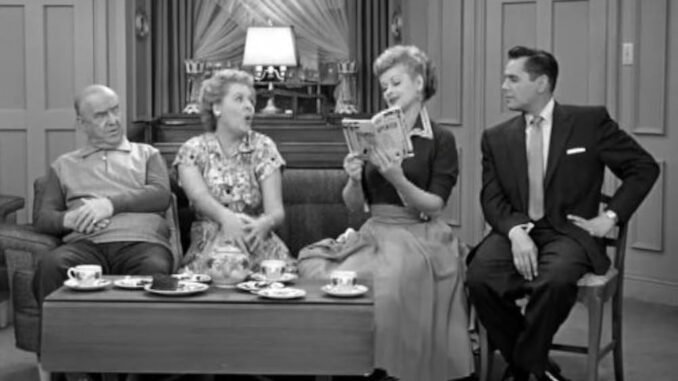
“Leave It to Beaver” and “I Love Lucy” are two classic television shows that entertained audiences during the Golden Age of Television. While both shows have become iconic, the producers of “Leave It to Beaver” intentionally steered away from the slapstick humor that made “I Love Lucy” such a sensation. Instead, they focused on creating a warm, relatable family dynamic that prioritized life lessons over laugh-out-loud moments. This deliberate approach to tone is what made “Leave It to Beaver” unique — and why it still resonates with viewers today. Let’s dive into the story behind this creative decision and explore why “Leave It to Beaver” wasn’t designed to follow in Lucy’s comedic footsteps.
Why Producers Chose a Different Path
Producers of “Leave It to Beaver” sought to create a show that felt authentic to the American family experience. Unlike “I Love Lucy,” known for its hilarious and sometimes outrageous scenarios, “Leave It to Beaver” was more grounded. The producers wanted to focus on everyday life and the kind of situations that real families could recognize, even if it meant dialing back on the comedy.
The Popularity of ‘I Love Lucy’ and Its Influence
“I Love Lucy” was an undeniable hit, setting a high bar for television comedy. The antics of Lucy Ricardo and her outlandish plans to become famous or keep up with her husband Ricky made for unforgettable television. However, this success also led other shows to consider how they could stand out in an era dominated by Lucy’s brand of humor.
Balancing Humor and Heart
“Leave It to Beaver” producers knew they couldn’t compete with “I Love Lucy” in terms of laugh-out-loud humor. Instead, they aimed to offer a show that felt more intimate and real. Rather than seeking belly laughs, they used humor subtly, weaving it into the fabric of family life without overshadowing the story’s warmth.
‘Leave It to Beaver’ as a Slice of Life
What Made It Unique? The goal of “Leave It to Beaver” was to showcase the everyday life of an American family, complete with moral lessons and relatable struggles. This approach made it less comedic but provided a different kind of value to audiences, who saw themselves in the Cleaver family’s day-to-day experiences.

The Intentional Tone of ‘Leave It to Beaver’
The show’s tone was a significant part of its charm. By opting for gentler humor, “Leave It to Beaver” created an environment where viewers could focus on the characters and their growth. Each episode left audiences with a moral takeaway rather than a simple punchline, giving the show a lasting appeal that was both touching and memorable.
Lessons Over Laughter
Why Did They Focus on Morals? The creators of “Leave It to Beaver” were intent on delivering messages about integrity, kindness, and responsibility. They wanted each episode to serve as a lesson that families could discuss and reflect on together. In doing so, the show provided a different form of entertainment that resonated deeply with viewers who appreciated its grounded approach.
How Humor Was Used Differently
While “I Love Lucy” relied on physical comedy and exaggerated situations, “Leave It to Beaver” used humor in a more reserved manner. Characters like Beaver and Wally provided laughs through their innocent mistakes and misunderstandings, but these moments were always rooted in real, relatable experiences.
The Family Dynamic on ‘Leave It to Beaver’
How It Captured Authentic Family Relationships The Cleaver family wasn’t perfect, but their imperfections were what made them real. Unlike Lucy and Ricky’s sometimes chaotic marriage, June and Ward Cleaver represented a stable, supportive partnership. Their parenting style provided a comforting backdrop that showed audiences the importance of understanding and patience.
Why ‘Leave It to Beaver’ Stuck to a Realistic Style
Producers feared that following in the footsteps of “I Love Lucy” would compromise the unique tone they were aiming for. By steering clear of overtly funny or surreal scenarios, they created a show that remained true to its vision of a realistic family, making it relatable for viewers of all ages.
How Audiences Responded to the Tone
Audiences appreciated the wholesome nature of “Leave It to Beaver.” While they may have laughed less frequently, they tuned in each week to watch the Cleaver family tackle real issues. This loyalty proved that the producers’ approach paid off, as viewers valued the moral depth of each episode.
The Lasting Legacy of ‘Leave It to Beaver’
Why It’s Still Loved Today “Leave It to Beaver” became a touchstone for family television, setting a standard for shows that emphasize life lessons over gags. Its decision to be less comedic than “I Love Lucy” has allowed it to retain a timeless quality, making it a beloved show that continues to captivate new generations.
Comparing ‘Leave It to Beaver’ and ‘I Love Lucy’
While the two shows differ significantly in tone, each has left an indelible mark on television. “I Love Lucy” introduced audiences to fast-paced humor and memorable punchlines, while “Leave It to Beaver” offered a quieter, more reflective viewing experience. Together, they showcase the versatility of classic TV.

Why Both Shows Are Iconic in Their Own Way
Despite their differences, both “Leave It to Beaver” and “I Love Lucy” have achieved legendary status. Each represents a distinct style that appealed to different facets of American life. “I Love Lucy” is cherished for its sheer hilarity, while “Leave It to Beaver” is treasured for its warm portrayal of family values.
Conclusion
“Leave It to Beaver” and “I Love Lucy” are two pillars of classic television that took very different approaches to storytelling. The producers of “Leave It to Beaver” intentionally veered away from slapstick humor to focus on relatable family experiences and meaningful lessons. This choice may have kept the laughs to a minimum, but it earned the show a special place in the hearts of viewers who connected with its honest depiction of family life. In the end, “Leave It to Beaver” and “I Love Lucy” each found success by staying true to their unique visions, proving that great television comes in many forms.
FAQs
- Why didn’t “Leave It to Beaver” aim for the same humor as “I Love Lucy”? Producers wanted to focus on relatable family stories and life lessons rather than comedic antics.
- What makes “Leave It to Beaver” different from “I Love Lucy”? While “I Love Lucy” was a comedy powerhouse with slapstick humor, “Leave It to Beaver” offered a more grounded, moral-focused narrative.
- Was “Leave It to Beaver” popular during its original run? Yes, it gained a loyal following for its wholesome approach and relatable storylines.
- How did the Cleaver family contribute to the show’s unique tone? Their family dynamic was realistic and heartwarming, helping the show emphasize life lessons over laughs.
-
Is “Leave It to Beaver” still relevant today? Absolutely. Its themes of family, integrity, and responsibility resonate with audiences even now.
